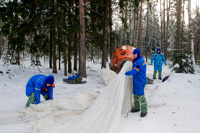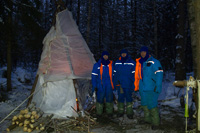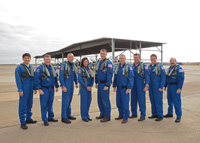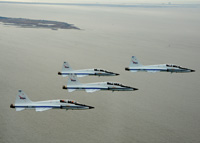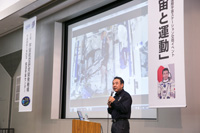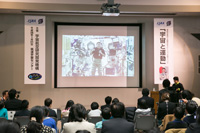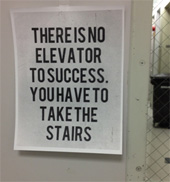Hello everyone!
This month I am going to continue on from last time with the story of how I became a test pilot. To be honest, what follows is almost identical to what I wrote in my Russian-language autobiography. When I had finished writing this in Russian, my Russian teacher’s comment was: ‘You haven’t written anything about your love life! You can tell me about that next time!’ I wonder if there will ever come a time when I write about my love life in this journal. Well, even if I did write about it, it wouldn’t take very long because I don’t have much experience...
Anyway, let’s get back to the story.
When I was sent to the US contrary to my own wishes, I wondered how I always managed to end up on the difficult path against my own intentions. But it was decided, there was nothing I could do about it. I started studying English really hard. After studying English for about two months in Japan, I left for the US. If you think you would be able to speak English no problem after two months of studying, you would be totally wrong. After I arrived in the US, I couldn’t even manage to order myself a hamburger! That was how I started my life there! I went to a language school in the US under these conditions but I only had 2 months until the start of flight training. When you are learning a language, 2 months is very short but it was a very significant period from other aspects. I was lucky enough to have the chance to visit the Johnson Space Center during a training weekend! Since I was little, I had always been interested in space and I found everything very interesting and even though I didn’t understand English, I remember looking around really diligently. The two things that impressed me in particular were the enormity of the Saturn rocket and the fact that the US had already sent men to the moon before I was even born. From this point on I really felt the national power of the US and thought that it was a country that we should never fight against in the future (I was a member of the Self-Defense Force so I often thought of military security guarantees).
My two months of language training in the US was over in a flash and I began flight training for the T-38. I had a really hard time during the training with my low level of English! Here is an example. When communicating with the air-traffic controller, you use the phrase, ‘Say again’ when the other person says something you don’t understand. One day, I was alone in a T-38 (solo flight training), heading towards the training area.
Me: Memphis center. Lancer ○○FL240. (I had reached 24000 feet and was leveling off)
Controller: ○○××△△
??!! (I have no idea what he said...I’ll get it this time) Say again?
Controller: ………Say again?
Me: !?!? (Oh no!) Say again?
Controller: ………Sorry…I don't understand you.
Me: (Oh no! Oh no! Help! Help!) Disregard...
Controller: ………Roger…
There is no way that flight training is going to go smoothly under these conditions! I devoted all my energy to English and flight training. Even when I was in the bath or bed, I was reading aircraft manuals and I worked on memorizing what was written there.
Thanks to these efforts, mutual understanding started to go a little bit better, at least for English that used terms from US army manuals.
When I managed to get to the stage in my training in the US where it looked like I would be able to obtain the wing mark which was the mark of a pilot, a new type of training started. After completing T-38 training, we had to move on a trial of the fighter jet operation course using AT-38 in the US! No Japanese person had ever taken this course before so there was no one I could ask when I didn’t understand as I had done in the past. I got more and more anxious as I thought about how hard things were going to get on this course. And on top of that, in order to participate in the fighter jet operation training, I had to go through g-force resistance training again. The result of trying my hardest during g-force resistance training was:
Situation during training
Operator: 2g…3g……
Me:「Grayout! (when the blood supply to your brain is insufficient and you can no longer see colours, only black and white) Hook, hook, hook… (Starting a special breathing method in which you strain your lower body and stomach. The blood then flows back into your brain and you can see colours again.)
Operator: 4g…5g…6g…
Me: Hook. Hook. (This is not good. I’ve lost the colors in my sight again. I have to try harder!) Hook…no, it’s no good. I can’t see what’s in front of me! (This is known as a black out. You are still conscious and your eyes are open but there is not enough blood supply and you can’t see out of your eyes. Everything goes black. This is the stage just before losing consciousness!)
Then I lost consciousness!! The operator pushed the emergency stop button and a loud buzzer began to sound.
Operator: Kimiya! Kimiya! Are you OK? Are you OK?
Quite a few seconds later.
Me: (jittery ? moving in spasms, I open my eyes) What? Em… (my brain wasn’t working properly for a while so I didn’t comprehend the situation and I was talking in Japanese!)
Operator: Kimiya! Kimiya! Are you OK?
30 seconds after losing consciousness:
Me: (suddenly understanding the situation) Oh!! I'm sorry! Yeah! I'm alright! I'm so sorry!
Operator: That's alright...
Me: (I lost consciousness again this time. Not to mention my neck really, really hurts due to whiplash.)
As you would expect, I totally lost my confidence after this third time and I started to think that I had made a mistake in trying to become a fighter pilot.
Meanwhile, it was at this point that I discovered a movie that would influence my life. I was at a rental store looking for a movie to watch on my day off when I came across a box with astronauts wearing spacesuits and a small spacecraft on it. It was The Right Stuff about test pilots who tested the limits of the performance of aircraft. And it was a story about these pilots, who have the ‘right stuff’ (fair and superior temperament/accomplishments) working towards manned space flight. At that time, along with coming into contact with the job of test pilot for the first time, I also thought that maybe Japan would need test pilots for manned space flight in the future. I came to think that if I became a test pilot, I would have the possibility of becoming an astronaut through the Self-Defense Force.
The fighter jet operation course with AT-38s in the US was only two months long but I really learned a lot. First of all, I learned that aerial combat is the application of physics! A certain chart which was the first thing we studied on this course became very interesting to me. It was an amazing graph on which you could see aircraft performance at a glance. You could see the turning ratio and circle when turning was performed at a certain speed and a certain number of gs or how kinetic energy was lost. And I realised that it was possible to create this kind of chart as a result of the work of a test pilot. I became really interested in this and after that, compared it to charts for various other aircraft and started to study charts for the fighter jets that I worked on.
On this course I also had the chance to hear lectures from fighter pilots with actual experience of combat. I was able to hear about really valuable experiences such as the psychological state in one’s first experience of combat, the panic when you lose sight of the enemy and what you are thinking when your life is threatened in such a way. Since then, I have also become interested in psychology and have looked for and read books about battle psychology and social psychology.
(The difficulties of combat in a fighter jet are not limited to just the difficulties of operating the aircraft. In the operation of ordinary aircraft, you only have to fly with fixed objects such as the horizon or the runway as your references but in combat between fighter jets, you can maneuver freely as you wish with the enemy plane as your reference. During this time both enemy and ally are affected by the laws of physics so both physics and psychology become important.)
My experience in the US and the skills I learned there all greatly changed my life as a member of the Self-Defense Force as well as my own personal life. Among these, the biggest change was
that, from then on, I aimed to be a great fighter pilot and then a test pilot and I started to choose the most difficult path of my own free will.
For example, after I returned to Japan, I had the opportunity to submit my wishes for which fighter I would fly. I wrote down F-15 of my own bat. (At that time there were three choices: F-1, F-4 and F-15 and F-15 pilots were said to be the best in the world so they were also popular among the students.) Of course, in order to fly an F-15, you have to be able to resist 9gs (nine times the gravitational acceleration of the earth). However, by this time, I had lost consciousness three times. You might think this seemed rash but in order to resist high g-forces such as this, I learned that lower body muscle strength and stamina was essential and I started to run seriously.
I had a clear dream, a clear aim and a clear goal and I was able to focus on my current situation and think about what efforts I should make in order to breach the gap between it and these dreams and goals, continuing to make the necessary efforts.
Then, another important thing happened…
In actual fact, a week before leaving for the US, I had met a cute, bubbly girl. I only saw her twice before going to the US but we wrote to each other while I was away and I proposed to her in a letter from America. I never spent a longer two weeks than the two after I posted the letter with the proposal until I received the reply! I will tell you more about this another time. I will stop here for now!
Next time will be about my training as a fighter jet operator. I will talk in detail about how I came to the final decision to become a test pilot.
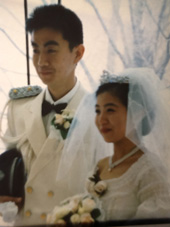
The proposal by letter turned out to be a great success. I got married straight after returning to Japan! People have said to me that I must be a gambler to propose to someone after having met them only twice… Even though we communicated by letter, we didn’t know everything about each other so it was one of the biggest gambles of my life. And the result? Of course, it was also the best gamble of my life!
*Photo: JAXA
